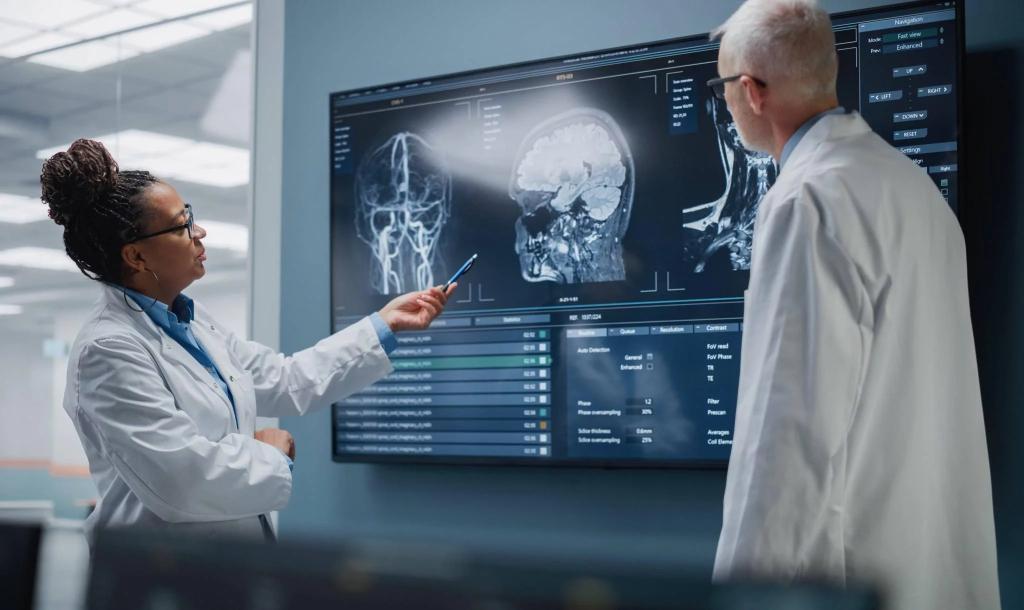Episodic migraine: Double-blind single-center study (Pilot study)[1]
This study evaluated the effectiveness of remote, nonpainful electrical stimulation on the upper arm to alleviate migraine pain. In a double-blind, randomized, crossover trial, migraine sufferers applied electrodes
shortly after the onset of an attack for 20 minutes, using different pulse widths. Participants avoided medication for 2 hours and used the device for up to 20 attacks. Among 71 patients (299 treatments), 64%
experienced a 50% pain reduction with pulse widths of 200-ms, 150-ms, and 100-ms, compared to 26% with
sham treatment. Active stimulation significantly reduced pain, likely due to the activation of descending
inhibition pathways through conditioned pain modulation.
Episodic migraine: Double-blind multi-center study (Pivotal study)[2]
This study evaluated the efficacy and safety of a remote electrical neuromodulation (REN) device for acute
migraine treatment. In a randomized, double-blind, sham-controlled trial across 12 sites, 252 adults with 2-8
migraines per month were assigned to either active or sham stimulation. Participants used a smartphone-
controlled device on the upper arm for 30-45 minutes within one hour of migraine onset. Pain levels and the
most bothersome symptoms (MBS) were recorded at baseline, 2 hours, and 48 hours post-treatment. Active
stimulation significantly outperformed sham treatment, with 66.7% achieving pain relief at 2 hours (vs. 38.8%
with sham), 37.4% becoming pain-free (vs. 18.4%), and 46.3% experiencing MBS relief (vs. 22.2%). The effects
persisted 48 hours post-treatment, with low and comparable rates of adverse events between groups. REN
provides superior and clinically meaningful relief from migraine pain and MBS compared to placebo.
Chronic migraine: Open label multi-center study (Pilot study)[3]
This study assessed the effectiveness and consistency of remote electrical neuromodulation (REN) using the
NerivioTM device for treating chronic migraine. In an open-label, single-arm study, adults with chronic migraine
used the REN device for 45 minutes within one hour of migraine onset over a 4-week period. Among 38
evaluable participants, 73.7% experienced pain relief at 2 hours, and 26.3% were pain-free. At 24 hours, 84.4%
had sustained pain relief, with 45.0% achieving sustained pain relief in at least 50% of their treated attacks. The
device was well-tolerated, with a low incidence of adverse events (1.8%). REN proved to be an effective, non-
pharmacological treatment for chronic migraine.
Chronic migraine: Open label multi-center study (Pivotal study)[4]
This study evaluated the safety and efficacy of remote electrical neuromodulation (REN) for treating chronic
migraine. In a 4-week open-label study, patients used the REN device (NerivioTM), with symptoms recorded at
treatment start, 2 hours, and 24 hours post-treatment. Among 91 evaluable subjects, 59.3% achieved pain
relief at 2 hours, and 20.9% were pain-free. At 24 hours, 64.4% had sustained pain relief. REN also reduced nausea, photophobia, and phonophobia, and improved functional ability. Only one device-related adverse
event was reported. REN proves to be a safe, drug-free option for acute migraine treatment in chronic
sufferers.
Adolescents with migraine: Open label multi-center study (Pivotal study)[5]
This study evaluated the safety and efficacy of remote electrical neuromodulation (REN) as a non-
pharmacological treatment for migraines in adolescents. In an open-label, multicenter study, 45 participants
aged 12–17 used the REN device (NerivioTM) over an 8-week period. Pain severity, associated symptoms, and
functional disability were recorded at treatment start, 2 hours, and 24 hours post-treatment. Among 39
participants who completed a test treatment, 71% achieved pain relief, and 35% were pain-free at 2 hours.
Additionally, 69% reported improved functional ability. One device-related adverse event was reported. REN is
a promising, well-tolerated alternative for treating acute migraines in adolescents.
Migraine prevention: Double-blind multi-center study (Pivotal study)[6]
This study evaluated the effectiveness of remote electrical neuromodulation (REN) for preventing migraines
when used every other day. In a prospective, randomized, double-blind, placebo-controlled trial, 248
participants were assigned to either REN or placebo stimulation for 8 weeks after a 4-week baseline phase.
Among the 179 participants in the modified intention-to-treat analysis, REN significantly reduced the average
number of migraine days per month compared to placebo, with a reduction of 4.0 days versus 1.3 days. REN
also outperformed placebo in reducing moderate/severe headache days, total headache days, and days of
acute medication use, with no serious device-related adverse events reported. REN proved to be an effective
and safe method for migraine prevention.
Contact: support@nerivio.co.za
References:
- Yarnitsky, D., Volokh, L., Alon Ironi, Weller, B., Shor, M., Shifrin, A. and Granovsky, Y. (2017). Nonpainful remote electrical stimulation alleviates episodic migraine pain. Neurology, 88(13), pp.1250–1255. doi:https://doi.org/10.1212/wnl.0000000000003760.
- Yarnitsky, D., Dodick, D.W., Grosberg, B.M., Burstein, R., Ironi, A., Harris, D., Lin, T. and Silberstein, S.D. (2019). Remote Electrical Neuromodulation (REN) Relieves Acute Migraine: A Randomized, Double‐Blind, Placebo‐Controlled, Multicenter Trial. Headache: The Journal of Head and Face Pain, 59(8), pp.1240–1252. doi:https://doi.org/10.1111/head.13551.
- Nierenburg, H., Vieira, J.R., Lev, N. et al. Remote Electrical Neuromodulation for the Acute Treatment of Migraine in Patients with Chronic Migraine: An Open-Label Pilot Study. Pain Ther 9, 531–543 (2020). https://doi.org/10.1007/s40122-020-00185-1
- Grosberg B, Rabany L, Lin T, Harris D, Vizel M, Ironi A, O'Carroll CP, Schim J. Safety and efficacy of remote electrical neuromodulation for the acute treatment of chronic migraine: an open-label study. Pain Rep. 2021 Oct 14;6(4):e966. doi: 10.1097/PR9.0000000000000966. PMID: 34667919; PMCID: PMC8519197.
- Hershey, A.D., Lin, T., Gruper, Y., Harris, D., Ironi, A., Berk, T., Szperka, C.L. and Berenson, F. (2020). Remote electrical neuromodulation for acute treatment of migraine in adolescents. Headache: The Journal of Head and Face Pain, 61(2), pp.310–317. doi:https://doi.org/10.1111/head.14042.
- Tepper, S.J., Liron Rabany, Cowan, R.P., Smith, T.W., Grosberg, B.M., Torphy, B.D., Harris, D., Vizel, M., Alon Ironi, Alit Stark‐Inbar and Blumenfeld, A.M. (2023). Remote electrical neuromodulation for migraine prevention: A double‐blind, randomized, placebo‐controlled clinical trial. Headache, 63(3), pp.377–389. doi:https://doi.org/10.1111/head.14469.




